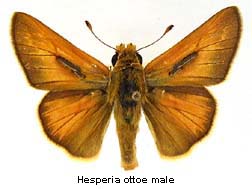We counted butterflies on transect surveys during Hesperia ottoe flight period in 1988–2011 at tallgrass prairie preserves in four states (Illinois, Iowa, Minnesota, Wisconsin), divided into units cross-referenced to vegetation type and management history. H. ottoe occurred only in dry and sand prairie types, and was significantly more abundant in undegraded than semi-degraded prairie, and in discontinuous sod (with numerous unvegetated areas due to bare sand and/or rock outcrops) than in continuous sod. This skipper was significantly more abundant in small sites compared to medium and large sites, even when the analysis was limited to undegraded prairie analyzed separately by sod type. H. ottoe was significantly under-represented in year-burn 0 (the first growing season after fire) compared to an expected distribution proportional to survey effort. However, H. ottoe was also over-represented in fire-managed units compared to non-fire-managed units. However, by far most units and sites were in fire management and most populations declined to subdetection during this study.
Peak abundance post-fire occurred in a later year-burn in discontinuous sod and was much higher than in continuous sod. We also analyze H. ottoe status and trend in midwestern prairie preserves by compiling a dataset of our and others’ butterfly surveys from 1974 to 2011. Only 1/9 sites with continuous sod had detectable H. ottoe in recent year(s). In discontinuous sod, 2/6 did, with two sites lacking data for the last few years. The number of years H. ottoe was still detectable after preservation and the number of years to consistent non-detection were both significantly higher in discontinuous than continuous sod. Both measures of population persistence averaged over twice as long in discontinuous than continuous sod, and correlated negatively with prairie size. The year when consistent non-detection began varied over several decades among sites. Despite the currently urgent need to identify how to manage preserves successfully for H. ottoe, such research now needs to be very cautious, because of the extreme fragility of the few remaining populations and the ruggedness of the preserves where H. ottoe is still known to occur.
Source: Swengel AB & Swengel SR (2013) Insects 4(4), 663-682; doi:10.3390/insects4040663

- Log in to post comments
